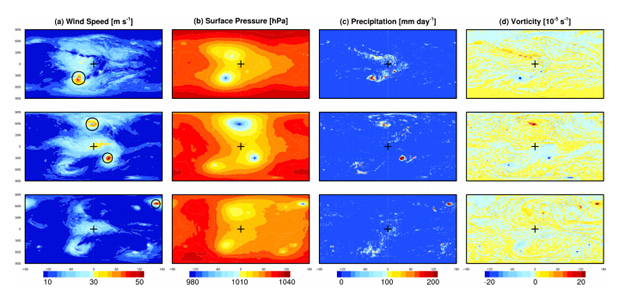Snapshots of the last model step of the CTLE and WTLE horizontal wind at stratospheric and mesospheric altitudes are shown in [Cold TLE and Warm TLE, above].... The CTLE and WTLE stratospheric horizontal wind at 36 km is shown [above]. In both simulations, a westward global zonal jet stream with an accompanying vortex located at polar latitudes is present. The vortex can be seen on the left hand side of the Southern and Northern Hemispheres [above]. The blue coloured regions on the right hand side of the Southern and Northern hemispheres, on the other hand, are regions of low HW speeds. The WTLE horizontal wind is slightly weaker and has a wider jet stream compared to the CTLE.The situation is different at mesospheric altitudes. At 60 km altitude, the zonal jet stream is replaced by large-scale vortices in both the CTLE and the WTLE, located at different geographical locations.
– https://progearthplanetsci.springeropen.com/articles/10.1186/s40645-016-0098-1
For orbital periods shorter than 12 days, towards the very inner edge of the habitable zone, the situation becomes more complex. We found that tidally locked planets on very tight orbits can assume first two different climate states (Climate I and II) and for orbital periods shorter than 5 days even three different climate states (Climate I, II and III).Climate I is associated with so called equatorial superrotation: This is a very fast and strong eastward wind jet along the equator in the upper atmosphere that can reach in our simulation wind speeds of 300 km/h and more. This climate state has already been observed for tidally locked gas planets. For rocky planets, superrotation apparently stops rising heated air over the day side from being transported towards the night side. The heat is thus stuck on the day side and the surface temperatures there can reach the boiling point of water – in particular for a two Earth-radii planet. Climate II, on the other hand, assumes instead two weaker eastward wind jets that circle the planet at higher latitudes, well away from the equator.
We find that hurricanes can form on the planets but not on all of them. For planets near the inner edge of the habitable zone of late M dwarfs, there are more and stronger hurricanes on both day and night sides. For planets in the middle and outer ranges of the habitable zone, the possibility of hurricane formation is low or even close to zero, as suggested in the study of Bin et al.(2017).We find that hurricanes can form on the planets but not on all of them. For planets near the inner edge of the habitable zone of late M dwarfs, there are more and stronger hurricanes on both day and night sides. For planets in the middle and outer ranges of the habitable zone, the possibility of hurricane formation is low or even close to zero, as suggested in the study of Bin et al.— (2017Mingyu Yan, Jun Yang; Hurricanes on Tidally Locked Terrestrial Planets: Fixed SST Experiments).




